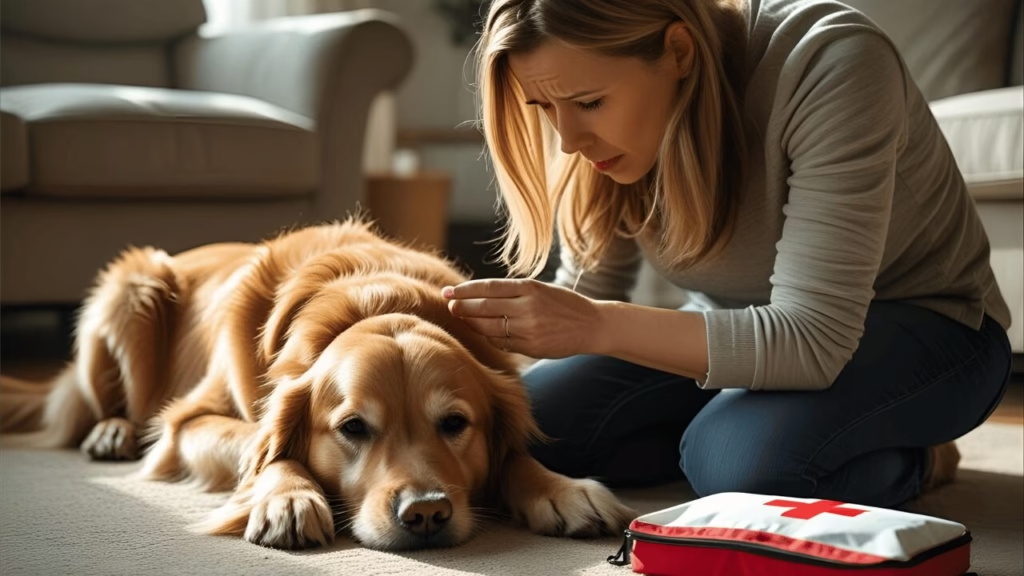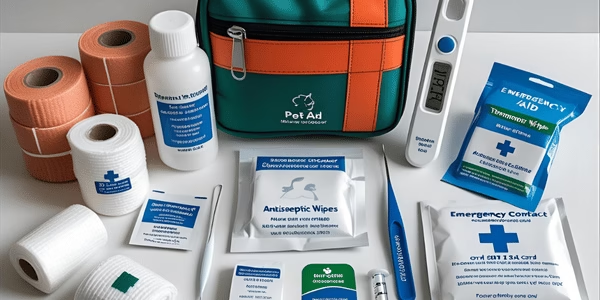So your dog just ate a grape, your cat is breathing funny, or your pet is acting like they’re drunk?
Been there. Done that. Got the vet bill to prove it.
Look, I get it. When your furry friend is in trouble, your brain basically shuts down and you’re left googling “is my dog dying” at 2 AM. But here’s the thing about pet emergency guide situations, they happen fast, and knowing what to do (or more importantly, what NOT to do) can literally save your pet’s life.
I’ve learned this the hard way after years of pet ownership and countless emergency vet visits. Some could have been avoided, others were unavoidable, but all taught me something valuable about emergency preparedness.
The truth is, most pet emergencies catch us completely off guard. One minute your pet is fine, the next they’re in serious trouble. And while we can’t prevent every accident, we can absolutely prepare for them.
What Actually Counts as a Pet Emergency?
Not every weird thing your pet does requires a midnight dash to the emergency vet. But some things absolutely do.
Call your vet immediately if you notice any of these critical signs:
- Difficulty breathing, gasping, blue gums, or can’t catch their breath
- Profuse bleeding that won’t stop after 10 minutes of direct pressure
- Loss of consciousness or sudden collapse
- Seizures, especially if they last more than 5 minutes
- Uncontrolled vomiting or diarrhea (particularly with blood)
- Inability to urinate or defecate
- Signs of extreme pain – crying, panting, restlessness
- Suspected poisoning – drooling, vomiting, disorientation
Here’s what I wish someone had told me years ago: trust your gut. If something feels seriously wrong, it probably is. I’ve never regretted erring on the side of caution with emergency vet visits, but I have regretted waiting “to see if it gets better.”
The difference between a true emergency and something that can wait often comes down to severity and your pet’s overall condition. A small cut that stops bleeding isn’t an emergency. A small cut that won’t stop bleeding after 10 minutes of pressure is.
Building Your Pet Emergency Action Plan
The Dr. ABCs Emergency Protocol
When your pet has an emergency, remember “Dr. ABCs” to keep yourself organized and focused:
Danger – Keep yourself safe first because you can’t help your pet if you’re injured too
Response – Check if your pet responds to their name or gentle touch
Airway – Ensure their airway is clear of visible obstructions
Breathing – Monitor if they’re breathing normally or showing distress
Circulation – Feel for a pulse and check gum color for signs of shock
Send – Get help immediately or call for professional assistance
This systematic approach prevents you from panicking and missing critical steps that could make the difference between life and death for your pet. When adrenaline kicks in, it’s easy to forget important details or skip crucial assessment steps.
Essential Emergency Contacts
Right now, before you continue reading, store these numbers in your phone:
- Your regular vet’s number with after-hours instructions
- Nearest 24-hour emergency vet clinic
- Pet Poison Helpline: 800-213-6680
- A backup emergency clinic (in case the first is full)
Having these numbers readily available eliminates precious time spent searching for contact information when every second counts. I’ve seen too many pet owners waste valuable minutes trying to remember their vet’s name or looking up emergency clinics online while their pet suffered.
Creating Your Pet First Aid Kit
Every pet owner needs a proper pet first aid kit, and most people underestimate how comprehensive it should be. Think of this as your pet’s life insurance policy, you hope you never need it, but you’ll be incredibly grateful it’s there when you do.
Your basic medical supplies should include various sizes of bandages and gauze pads for wound care, self-adhesive tape that won’t stick to fur, blunt-ended scissors for cutting bandages safely, and both regular tweezers and specialized tick removal tweezers.
You’ll also need cotton wool and cotton swabs for cleaning wounds, wound wash or saline solution for flushing injuries, antiseptic wipes for disinfecting, and vinyl gloves to protect both you and your pet. An instant cold compress can help with swelling and pain, while a foil emergency blanket helps prevent shock. An oral syringe is essential for giving liquid medications when your pet won’t cooperate.
Don’t forget these often-overlooked items:
- Your vet’s contact information printed on waterproof paper
- Recent photos of your pet (in case they get lost during an emergency)
- Copies of vaccination records for emergency vet visits
- Current medication list with dosages
- Emergency cash specifically set aside for unexpected vet bills
Keep a smaller version of this kit in your car if you travel with your pet frequently, because emergencies don’t only happen at home. I learned this lesson the hard way during a camping trip when my dog stepped on broken glass miles from the nearest vet.
Common Pet Emergencies: What to Do and What NOT to Do
Pet Respiratory Distress
Breathing problems in pets can escalate frighteningly fast, and recognizing the signs early can save your pet’s life. This is one area where minutes truly matter.
Watch for these warning signs:
- Rapid breathing or continuous panting (when not hot or after exercise)
- Blue or pale gums indicating oxygen deprivation
- Standing with elbows out and neck extended to maximize airflow
- Open mouth breathing, especially in cats who normally breathe through their noses
- Any wheezing, coughing, or noisy breathing
When you notice these signs, keep your pet as calm and quiet as possible because stress makes breathing problems worse. If you can safely see into their mouth and spot a visible obstruction, you can attempt to remove it, but don’t risk getting bitten or pushing the object further back. Get to the vet immediately because respiratory distress is always an emergency, regardless of the underlying cause.
What you absolutely must not do is restrain your pet if they’re struggling to breathe, as this increases their panic and oxygen demand. Never wait to see if breathing problems improve on their own because respiratory distress typically worsens rapidly without intervention.
Respiratory distress can result from heart problems, pneumonia, allergic reactions, or foreign objects lodged in the airway. Whatever the cause, it requires immediate veterinary attention because pets can suffocate or go into cardiac arrest within minutes.
Pet Seizures
Watching your pet have a seizure is absolutely terrifying, but understanding what’s happening helps you respond appropriately instead of panicking.
Seizures don’t always look like the dramatic “shaking on the side” that we see in movies. They can manifest as staring into space without responding to their name, facial twitching or “fly biting” behavior where they snap at invisible objects, excessive drooling or loss of bladder control, and significant changes in behavior before or after the seizure such as becoming clingy, fearful, or confused.
During a seizure, your primary job is keeping your pet safe from injury. Move them away from stairs, furniture, or anything they could hurt themselves on, but never put your hands near their mouth because they might bite without realizing it. Don’t try to restrain them because this can cause injury to both of you. Instead, time the seizure and video it if possible, as this information helps your vet determine the cause and severity. Stay calm and speak softly because your pet can often hear you even during the seizure.
Call the vet immediately for:
- Any first-time seizure
- Seizures lasting longer than 5 minutes
- Multiple seizures within 24 hours
- If your pet doesn’t return to normal within an hour
These situations can indicate serious underlying conditions that require immediate treatment, from brain tumors to metabolic disorders.
Pet Heatstroke
Heatstroke is one of the most preventable yet deadly pet emergencies, and it happens faster than most people realize. Dogs and cats can’t regulate their body temperature as effectively as humans, making them vulnerable even in moderately warm weather.
Early warning signs include excessive panting and drooling beyond what’s normal for the temperature, weakness or lethargy when your pet would normally be active, vomiting or diarrhea, and an elevated body temperature that you can feel when touching their ears or belly.
Advanced signs indicate immediate life-threatening danger and include disorientation where your pet seems confused or unsteady, seizures, collapse where your pet can’t stand or walk, and bloody vomit or diarrhea which signals organ damage.
For immediate treatment, move your pet to shade or air conditioning immediately. Use cool, not cold, water to wet their body, or apply wet towels to their chest, belly, and paw pads. Offer small amounts of water if they’re conscious and able to drink, but don’t force it. Head to the vet immediately while continuing cooling efforts during transport.
The critical mistake that can kill your pet is immersing them in ice-cold water, which causes blood vessels to constrict and can send them into shock. The goal is gradual cooling, not rapid temperature change.
Heatstroke can kill in under an hour, making this always a race against time. Even if your pet seems to recover, they still need veterinary evaluation because organ damage can occur that isn’t immediately visible.
Pet Minor Injuries
Not every injury requires emergency treatment, but knowing how to handle minor issues properly prevents them from becoming major problems that need expensive emergency intervention.
Broken nails are common and painful but manageable at home in many cases. Control bleeding with direct pressure using a clean cloth or apply styptic powder if you have it. Your pet will likely need gentle restraint or even a muzzle due to pain, so approach carefully. Try to gently remove the broken piece if it’s hanging loosely, but see your vet if you can’t remove it easily or if bleeding won’t stop.
Bumps, bruises, and sprains from minor falls or rough play require careful observation. Look for swelling around the affected area, limping or favoring one leg, or tenderness when you gently touch the area. Keep your pet quiet and restrict their exercise for at least 24 hours. Contact your vet if symptoms continue for more than a couple of days or if they worsen instead of improving.
Small cuts and grazes can often be managed at home initially. Clean the wound with saline solution or clean water, apply direct pressure to control bleeding using a clean cloth, and use a clean dressing secured with a bandage. The key is preventing your pet from licking the wound, which introduces bacteria and slows healing.
Pet Major Injuries
Major injuries require immediate veterinary attention, but how you handle the first few minutes can determine whether your pet survives.
Heavy bleeding is always an emergency that requires quick action. Apply direct pressure with clean towels or gauze and maintain that pressure without lifting to “check” the wound for at least three full minutes. If bleeding continues, add another layer of dressing on top rather than removing the blood-soaked materials. Elevate the injured area if possible while maintaining pressure, and get to the vet immediately while continuing to apply pressure during transport.
Suspected broken bones require careful handling to prevent further injury. Keep your pet confined in a small area to prevent movement that could worsen the fracture. Only apply a splint if you have proper training, as improper splinting can cause more damage. Transport your pet carefully to avoid jostling the injured area, using a stretcher or board if possible for larger dogs.
Burns require immediate cooling and professional treatment. Flush the burned area with cool, not cold, water for several minutes. Never apply ice, butter, or home remedies like oils or ointments, as these can worsen the injury. Cover the burn with a clean, damp cloth and see your vet immediately because burns often look less severe than they actually are.
Pet Poisoning
Pet poisoning cases are where people make the most dangerous mistakes, often because they panic and try to help in ways that actually make things worse.
Common signs of poisoning include vomiting or diarrhea that comes on suddenly, drooling or obvious mouth irritation, difficulty breathing or rapid breathing, seizures or convulsions, and significant changes in behavior or consciousness level such as extreme lethargy or hyperactivity.
What you should do immediately is call your vet or the Pet Poison Helpline at 800-213-6680 for professional guidance. Take a picture of what your pet got into, including any packaging or labels, and bring all materials with you to the vet. If your pet was exposed to fumes or gas, get them to fresh air immediately while calling for help.
The critical mistake that can kill your pet is inducing vomiting unless specifically instructed to do so by your vet or poison control. Some substances, particularly caustic chemicals or petroleum products, cause more severe damage coming back up and can burn the esophagus or be inhaled into the lungs.
Pet Choking
Choking is terrifying to witness, but knowing how to respond can save your pet’s life in the crucial minutes before you reach veterinary care.
Signs that your pet is choking include persistent coughing, gagging, or retching that doesn’t produce anything, pawing at their mouth or face repeatedly, obvious difficulty breathing with extended neck and open mouth, and blue gums or tongue indicating oxygen deprivation.
If you can safely open your pet’s mouth and see the object causing the blockage, try to remove it using tweezers or needle-nose pliers, but be extremely careful not to push it further back. For small dogs and cats, you can hold them upside down and give several sharp blows to the back between the shoulder blades. For large dogs, lift their hind legs while they stand and give firm back blows, similar to the Heimlich maneuver position.
Know when to stop trying and head for emergency care. If you can’t remove the object quickly and safely, continuing to attempt removal can push it further down the throat. Get to the vet immediately while calling ahead to let them know you’re coming with a choking pet.
Advanced Emergency Preparedness
Creating a Pet Evacuation Plan
Natural disasters and emergencies don’t give you time to think or plan, which is why having a comprehensive evacuation plan ready can save both your life and your pet’s life.
Start by identifying pet-friendly hotels and emergency shelters in your area and in locations where you might evacuate. Many emergency shelters don’t accept pets, so having this information in advance prevents you from being separated from your pet during a crisis. Keep pet carriers easily accessible in your home, not buried in a closet or garage where you can’t reach them quickly.
Prepare a “grab bag” that stays packed with three to seven days’ worth of food, any medications your pet takes, copies of important documents like vaccination records, and comfort items like a favorite toy or blanket. Ensure your pet’s ID tags and microchip information are current and include your cell phone number, not just your home number.
Arrange a buddy system with neighbors or friends who can check on your pets if you’re not home during an emergency, and offer to do the same for them. Make sure they know where you keep emergency supplies and have keys or access codes to your home.
The Psychology of Pet Emergencies
Here’s something most vets don’t tell you: your emotional state directly affects your pet’s stress level during emergencies, which can impact their condition and recovery.
Staying calm helps because pets are incredibly sensitive to our anxiety and panic, often becoming more distressed when they sense our fear. Clear thinking leads to better decisions about treatment options and care priorities. Your pet is more likely to cooperate with necessary treatment if you’re calm and reassuring. Additionally, veterinary staff can work more effectively when owners aren’t panicking and demanding constant updates or interfering with treatment.
Techniques that actually work in emergency situations:
- Take three deep breaths before taking any action to engage rational thinking
- Speak to your pet in a soft, reassuring voice throughout the emergency
- Focus on the immediate next step rather than worst-case scenarios
- Remember that most pet emergencies have good outcomes when handled properly
Financial Preparation for Pet Emergencies
Let’s address the elephant in the room that many pet owners don’t want to think about: emergency vet bills can be financially devastating, and the cost shouldn’t be the deciding factor in your pet’s treatment.
Emergency vet visits commonly cost between one thousand and five thousand dollars, and complex surgeries can exceed ten thousand dollars. Having a financial plan prevents you from making life-or-death decisions based solely on money.
Consider these financial preparation strategies:
- Pet insurance (research policies before you need them, most have waiting periods)
- Emergency savings fund specifically for pet expenses
- Care Credit or similar veterinary financing options
- Find vets in your area that offer payment plans
- Research pet emergency assistance programs in your community
Planning ahead ensures that you can focus on getting your pet the care they need rather than worrying about how you’ll pay for it.
When to Rush to the Emergency Vet vs. Wait Until Morning
This decision keeps pet owners awake at night, literally, wondering if they’re overreacting or if their pet really needs immediate attention.
Rush to the emergency vet immediately for:
- Any breathing difficulties (can become life-threatening within minutes)
- Heavy bleeding that won’t stop despite direct pressure
- Suspected poisoning (treatment effectiveness decreases rapidly over time)
- Seizures, especially first-time seizures or those lasting more than a few minutes
- Loss of consciousness or collapse
- Extreme pain or distress that’s obvious and persistent
- Heatstroke symptoms
- Choking situations
- Eye injuries (can result in permanent vision loss)
- Bite wounds, especially from unknown animals
Probably safe to wait until morning:
- Minor cuts that have stopped bleeding and show no infection signs
- Mild limping without obvious distress that doesn’t worsen with rest
- Occasional vomiting without blood that doesn’t persist
- Eating slightly less than usual without other symptoms
- Minor bumps or bruises that don’t cause significant pain
When you’re genuinely unsure, call the emergency vet for phone guidance. Most emergency clinics will give you advice over the phone about whether your pet needs to be seen immediately, and this consultation can save you both money and unnecessary stress.
Teaching Kids About Pet Emergency Safety
If you have children in your home, they need to understand basic pet emergency protocols because they might be the first to notice something wrong with your pet.
Teach them these essential safety rules:
- Never approach an injured or scared pet, even their beloved family pet
- Get an adult immediately if anything seems wrong with a pet
- Know where the pet first aid kit is located
- Understand that injured pets might react unpredictably
- Know important emergency phone numbers or how to find them quickly
Practice emergency scenarios with your children, such as what to do if they find the pet bleeding, how to safely move the pet away from danger without getting hurt themselves, and when to call for adult help immediately. This preparation helps them respond appropriately rather than panicking or making dangerous mistakes.
The Most Important Thing About Pet Emergencies
Here’s what I wish every pet owner understood from day one: preparation beats panic every single time, and it can literally mean the difference between life and death for your pet.
You’re not being paranoid or overly cautious by having a comprehensive emergency plan. You’re being a responsible pet owner who understands that emergencies are not a matter of if, but when.
Most pet emergencies happen at the worst possible times when regular veterinary care isn’t available. Weekends, holidays, and the middle of the night seem to be when pets decide to have their medical crises. Having supplies ready, knowing what to do, and staying calm can save your pet’s life and save you from the helpless feeling of not knowing how to help your beloved companion.
The pet emergency situations I’ve handled best were the ones I was prepared for mentally and practically. The ones that went poorly were the ones where I panicked and made decisions based on fear rather than knowledge.
So take the time now, while your pet is healthy and happy, to get prepared. Build that comprehensive first aid kit and keep it properly stocked. Program those emergency phone numbers into your phone and make sure other family members know them too. Learn the basics of pet first aid through online resources or local classes. Create your evacuation plan and practice it occasionally.
Because when your pet needs you most, you’ll be ready to help them effectively rather than being paralyzed by panic and uncertainty. And that confidence and preparation is worth more than all the Netflix shows you could be watching instead of preparing for emergencies.
Frequently Asked Questions
How do I know if my pet’s breathing is an emergency?
Blue gums, gasping for air, or inability to breathe comfortably are always emergencies requiring immediate veterinary attention. Rapid breathing or panting when your pet hasn’t been active can also indicate serious problems and should be evaluated by a vet immediately.
Should I induce vomiting if my pet ate something toxic?
Never induce vomiting unless specifically instructed by your veterinarian or Pet Poison Helpline. Some substances cause more severe damage coming back up and can burn the esophagus or be inhaled into the lungs.
What’s the difference between a minor and major pet injury?
Minor injuries include small cuts, broken nails, or mild sprains that aren’t causing extreme distress and can often be managed initially at home. Major injuries involve heavy bleeding, suspected fractures, or any injury causing severe pain or affecting your pet’s ability to function normally.
How long can a pet seizure last before it becomes dangerous?
Any seizure lasting longer than five minutes is an emergency requiring immediate veterinary intervention. Multiple seizures occurring within 24 hours or first-time seizures also require immediate professional attention.
What should I do if my pet is choking but I can’t remove the object?
Stop trying to remove the obstruction and get to the veterinary emergency clinic immediately. Continuing to attempt removal can push the object further down the throat and make the situation worse, so professional intervention is needed.









